Introduction
Neuroevolution is a captivating field where AI merges neural networks and evolutionary algorithms to nurture its creative abilities. It’s akin to AI’s artistic or musical journey, allowing it to paint masterpieces and compose symphonies. This article delves into neuroevolution, exploring its mechanics, applications, and significance. It’s like AI’s quest for self-improvement, reminiscent of a budding artist perfecting their craft. Neuroevolution empowers AI to evolve, enhancing its problem-solving skills, artistic talents, and gaming prowess. This journey embodies AI’s growth, like humans’ continuous development, propelling it toward creative excellence.
This article was published as a part of the Data Science Blogathon.
Understanding Neuroevolution
Imagine if AI could learn and grow like living creatures. That’s the essence of neuroevolution.
Evolutionary Algorithms
These are like AI’s survival games. They create many AI players, let them compete, and only keep the best. Then, the winners become parents for the next generation. This cycle repeats until AI masters its tasks.
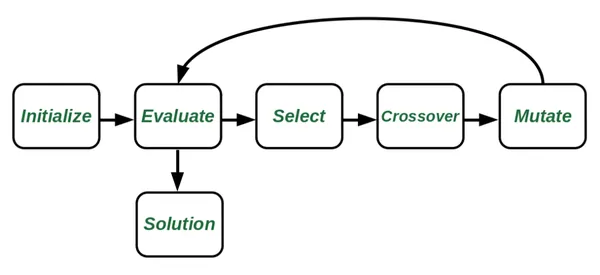
- Initialize: Start by creating an initial group of possible solutions.
- Evaluate: Assess each solution’s performance based on the problem’s goals.
- Select: Choose the best solutions as parents for the next generation.
- Crossover: Parents combine their traits to create new solutions.
- Mutate: Introduce random changes to add diversity to the offspring.
- Solution: After several generations, you should have improved solutions to the problem.
Evolutionary algorithms mimic the process of natural selection. They create a population of AI models, evaluate their performance, select the best ones, and breed them to create the next generation.
# A simple genetic algorithm for optimization
population = initialize_population()
while not termination_condition_met():
fitness_scores = evaluate_population(population)
selected_population = select_best_individuals(population, fitness_scores)
offspring = breed(selected_population)
population = replace_population(population, offspring)
Neural Networks
Think of neural networks as AI’s brain. They consist of tiny decision-makers (neurons) that help AI understand and learn from the world. In neuroevolution, these networks become the canvas for AI’s creativity.
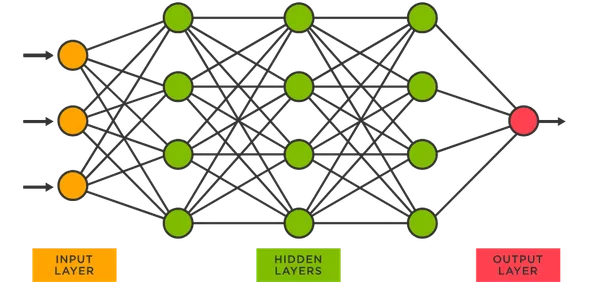
Neural networks are like AI’s brain. They consist of layers of interconnected nodes (neurons) that process information. Here’s a basic example of creating a neural network in Python using TensorFlow/Keras:
import tensorflow as tf
from tensorflow import keras
# Define a simple neural network
model = keras.Sequential([
keras.layers.Dense(64, activation='relu', input_shape=(input_size,)),
keras.layers.Dense(32, activation='relu'),
keras.layers.Dense(output_size, activation='softmax')
])
# Compile the model
model.compile(optimizer="adam", loss="categorical_crossentropy", metrics=['accuracy'])
Note: These code snippets provide a simplified understanding of how evolutionary algorithms and neural networks work in neuroevolution.
Code Explanation in Creating Neural Network Model
- Create the first layer with 64 decision-makers (neurons) and use the ‘relu’ activation function.
- Add a second layer with 32 neurons and ‘relu’ activation, and a final layer with ‘output_size’ neurons and ‘softmax’ activation.
- The model function provides a concise overview of the neural network. It shows the architecture, the number of trainable parameters, and the output shape of each layer. This summary helps you understand the structure and complexity of your neural network at a glance.
Neuroevolution vs. Traditional AI
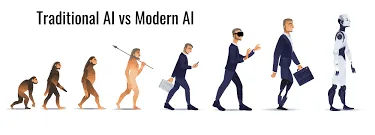
- Learning Like Life: Neuroevolution lets AI learn and adapt, much like living creatures. Unlike traditional AI, it doesn’t rely heavily on human programming or labeled data.
- Evolutionary Algorithms: Think of these as AI’s survival games. They create a mix of AI agents, let them compete, and select the best for the next generation. This process repeats until AI excels in tasks.
- Neural Networks as Brains: In neuroevolution, neural networks act as AI’s brains. They’re like interconnected decision-makers (neurons) in a biological brain. These nodes make choices, process information, and help AI learn about the world.
Why is Neuroevolution Important?
- Unlocking Creativity: Neuroevolution encourages AI to be creative. Unlike traditional AI, which follows strict rules or instructions, it lets AI explore innovative solutions independently. This can lead to new ideas, strategies, and art.
- Adaptability: Neuroevolution is flexible. Unlike fixed algorithms, AI can adjust to different situations and tasks. This makes it suitable for various applications, from designing games to solving complex problems.
- Less Manual Work: Unlike traditional AI, which often needs lots of manual effort, neuroevolution relies on AI evolving itself. This means less time spent on data labeling and rule creation.
Applications of Neuroevolution
- Game Design: Neuroevolution can design game characters and strategies. It’s like teaching AI to become a chess grandmaster or a pro gamer.
Here’s a simple example using Python and the NEAT (NeuroEvolution of Augmenting Topologies) library:
import neat
# Define the game environment and AI agent
game = Game()
ai_agent = NeuralNetwork()
# Create a NEAT population
config = neat.Config(neat.DefaultGenome, neat.DefaultReproduction,
neat.DefaultSpeciesSet, neat.DefaultStagnation, 'neat_config.txt')
population = neat.Population(config)
# Define the evaluation function for AI
def evaluate_ai(ai_agent, generations=10):
fitness = 0
for _ in range(generations):
game.reset()
while not game.over():
action = ai_agent.make_decision(game.state)
game.take_action(action)
fitness += game.get_score()
return fitness
# Train the AI using neuroevolution
def eval_genomes(genomes, config):
for genome_id, genome in genomes:
ai_agent = neat.nn.FeedForwardNetwork.create(genome, config)
genome.fitness = evaluate_ai(ai_agent)
# Start neuroevolution
winner = population.run(eval_genomes, generations=100)
Code summary: This code utilizes the NEAT (NeuroEvolution of Augmenting Topologies) library to train an AI agent to play a game. It creates a population of AI agents with evolving neural networks, evaluates their performance in the game, and selects the fittest agents for further evolution. After several generations, the best-performing AI agent is identified as the winner.
- Art and Music: Have you ever seen AI paint or compose music? Neuroevolution can do that. It’s like having an AI Picasso or Beethoven
Below is a simple Python example using the NEAT-Python library to evolve an image:
import neat
from PIL import Image
# Create a blank image
img = Image.new('RGB', (300, 300))
# Define the evaluation function for image generation
def evaluate_image(image):
# Your evaluation code here
return fitness_score
# Define the NEAT configuration
config = neat.Config(neat.DefaultGenome, neat.DefaultReproduction,
neat.DefaultSpeciesSet, neat.DefaultStagnation, 'neat_config.txt')
# Create a NEAT population
population = neat.Population(config)
# Start neuroevolution for image generation
def eval_genomes(genomes, config):
for genome_id, genome in genomes:
image = generate_image(genome) # Implement this function to generate images
genome.fitness = evaluate_image(image)
winner = population.run(eval_genomes, generations=100)
Code summary: This code utilizes the NEAT (NeuroEvolution of Augmenting Topologies) library to evolve images. It starts with a blank image and uses a custom evaluation function to evaluate its fitness. The NEAT algorithm runs for multiple generations, optimizing the images and selecting the best image as the winner.
- Problem-Solving: Neuroevolution isn’t just for fun; it’s also a problem solver. It can help AI figure out complex puzzles, like optimizing supply chains or designing efficient machines.
Here’s a simplified example using a genetic algorithm to optimize a mathematical function:
import numpy as np
# Define the optimization function
def fitness_function(x):
return -np.sin(x) * x + 0.5 * x
# Define the genetic algorithm parameters
population_size = 100
num_generations = 50
mutation_rate = 0.01
# Initialize a population of solutions
population = initialize_population(population_size)
# Genetic algorithm loop
for generation in range(num_generations):
# Evaluate the fitness of each solution
fitness_scores = evaluate_fitness(population, fitness_function)
# Select the best solutions
selected_population = select_best_solutions(population, fitness_scores)
# Create offspring through crossover and mutation
offspring_population = create_offspring(selected_population, mutation_rate)
# Replace the old population with the new population
population = offspring_population
# The best solution found is the optimal solution
best_solution = select_best_solutions(population, fitness_scores)[0]Code Summary: This code implements a genetic algorithm to find the optimal solution for a given fitness function. It starts with a population of potential solutions, evaluates their fitness, selects the best ones, creates offspring through crossover and mutation, and repeats this process for multiple generations. The best solution found is considered the optimal one.
NEAT: NeuroEvolution of Augmenting Topologies
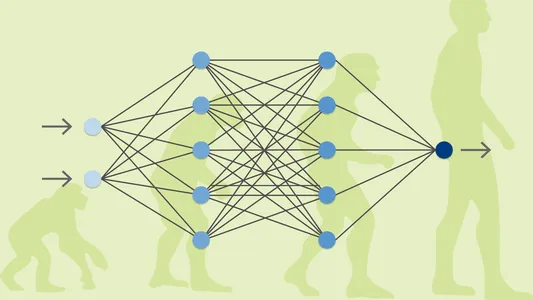
- It’s a technique in neuroevolution that helps AI build and improve neural networks.
- Working: NEAT starts with simple neural networks and gradually adds complexity. It’s like evolving AI brains step by step. It lets AI create new connections and nodes, trying to find the best network for a task.
- Significance: NEAT is significant because it makes neuroevolution more efficient. Instead of starting with complex neural networks, which might not work well, NEAT begins with simplicity and evolves from there. This approach saves time and resources, making AI learning smarter and faster.
Limitations, Challenges, and Future Directions
- Computational Complexity: Neuroevolution can be computationally demanding, requiring substantial resources and time. Researchers are working on making the process more efficient.
- High Computational Demands: Neuroevolution can be computationally expensive, requiring significant processing power and time, especially for complex tasks.
- Difficulty in Encoded Tasks: Designing an effective encoding scheme for complex tasks can be challenging, as finding the right representation is not always straightforward.
- Limited Explainability: Neural networks in neuroevolution can lack transparency, making it difficult to understand the decision-making process of evolved AI systems.
- Ethical Considerations: As AI creativity grows, ethical questions emerge, such as ownership of AI-generated content and the impact on human creators.
More on Ethical Considerations
- Ownership of Generated Content: Neuroevolution raises questions about who owns the AI-generated content, such as art or music. Clear guidelines on intellectual property rights are needed.
- Bias and Fairness: There’s a risk of perpetuating biases in training data, potentially leading to biased or unfair AI-generated content.
- Loss of Human Creativity: The widespread use of AI-generated art and music could overshadow human creativity in these domains, impacting artists and their livelihoods.
Conclusion
Neuroevolution, with its ability to foster AI creativity, presents an exciting frontier with vast possibilities. It is poised to revolutionize industries by introducing AI-driven innovations that were once unimaginable. Neuroevolution’s impact spans various applications, from gaming to art and complex problem-solving.
Yet, as this field matures, it necessitates carefully examining its challenges and ethical dimensions. The questions of who owns AI-generated content and how to ensure fairness and transparency in its creations need thoughtful answers. Additionally, there’s the concern that AI’s creative prowess might overshadow human creativity.
In conclusion, neuroevolution is not merely a technological advancement; it’s a bridge between artificial intelligence and creativity. Its journey has just begun, and its destination holds promises and challenges. By navigating this path conscientiously, we can unlock AI’s creative potential for the betterment of society, all while respecting the ingenuity of the human spirit.
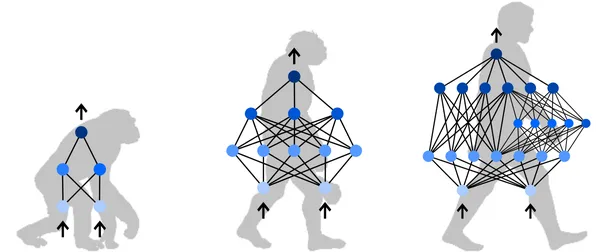
Key Takeaways
- Neuroevolution blends neural networks and evolution to make AI more creative.
- It finds its place in games, art, and problem-solving.
- It uses genetic algorithms, neural network designs, and fitness scores.
- Challenges include being computationally intense and raising ethical questions.
Frequently Asked Questions
A. Neuroevolution is a technique where AI learns and improves over generations, similar to how living creatures evolve. It uses algorithms that create a population of AI models, evaluate their performance, select the best ones, and allow them to reproduce to create the next generation.
A. Neuroevolution’s applications are quite diverse. It’s a powerful game design tool that can develop intelligent game characters and strategies. Beyond that, it extends its creativity to art and music, with the ability to generate paintings or compose music. Additionally, neuroevolution is a valuable problem-solving tool, aiding in tasks like optimizing supply chains and designing efficient machinery.
A. You’ll need libraries or frameworks like NEAT (NeuroEvolution of Augmenting Topologies) to apply neuroevolution to game design and art generation. You’ll define the AI environment, create a population, evaluate AI agents, and iterate through generations to train your AI for specific tasks.
A. Yes, there are ethical concerns regarding AI-generated content. AI becomes more creative and raises questions about ownership and copyright for generated art and music. Additionally, it’s essential to ensure that AI is used responsibly and doesn’t harm society or replace human creativity.
The media shown in this article is not owned by Analytics Vidhya and is used at the Author’s discretion.






